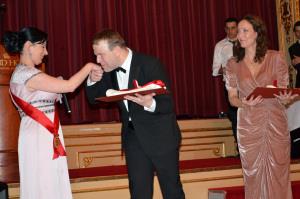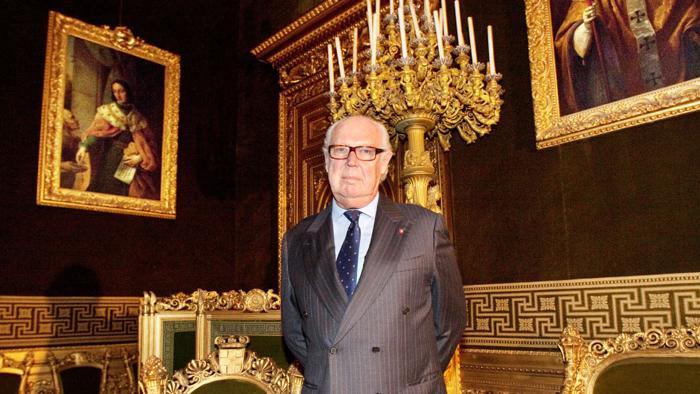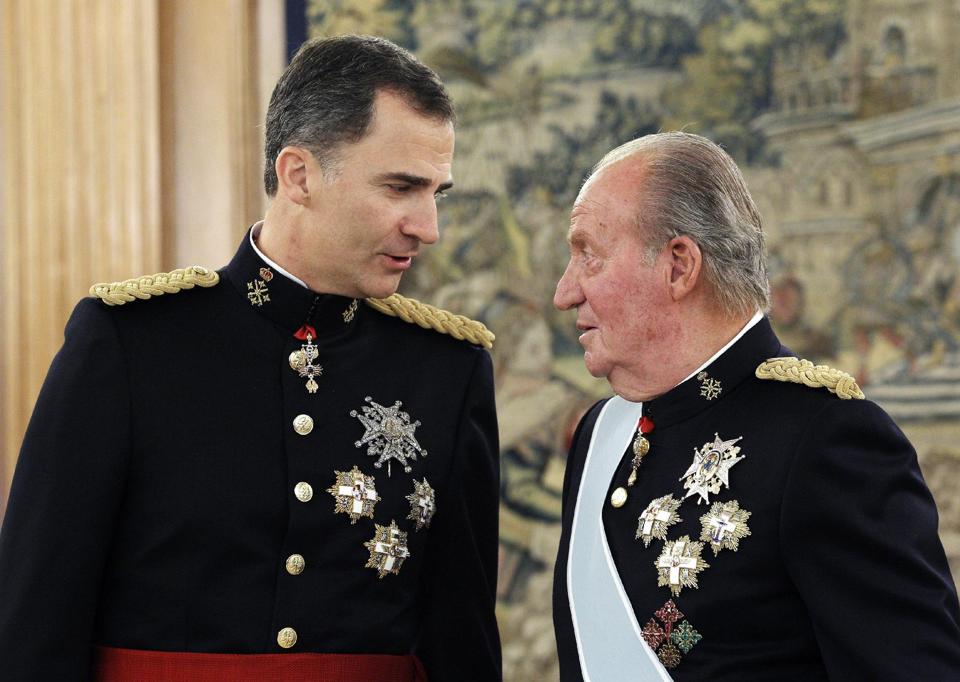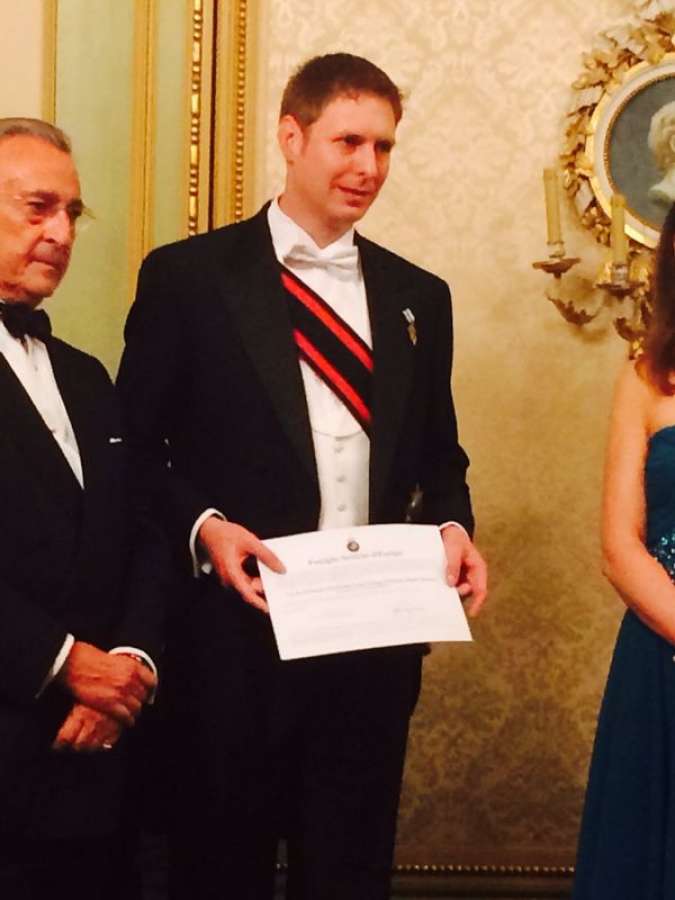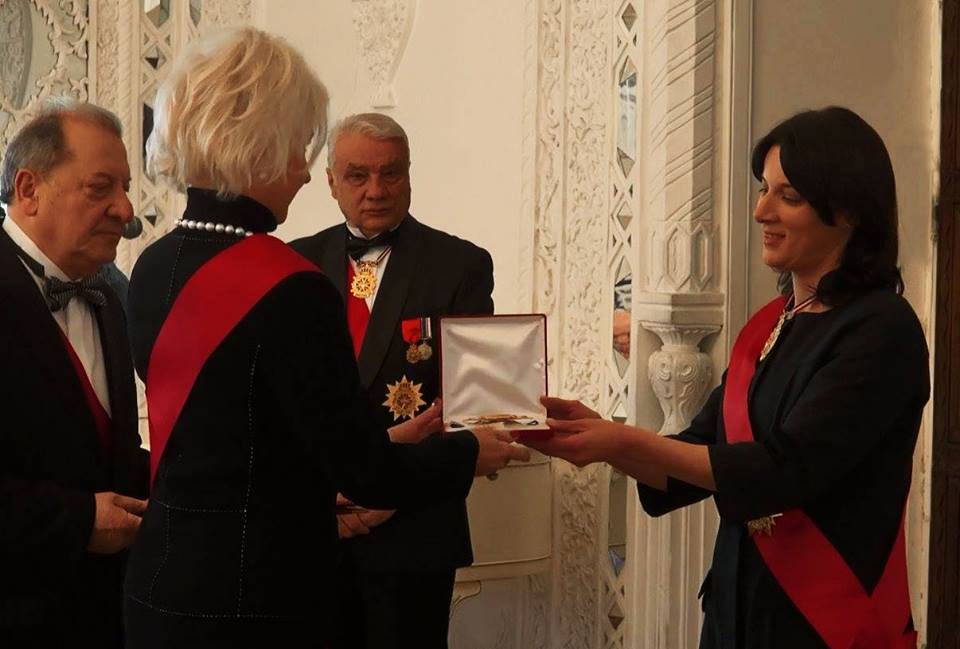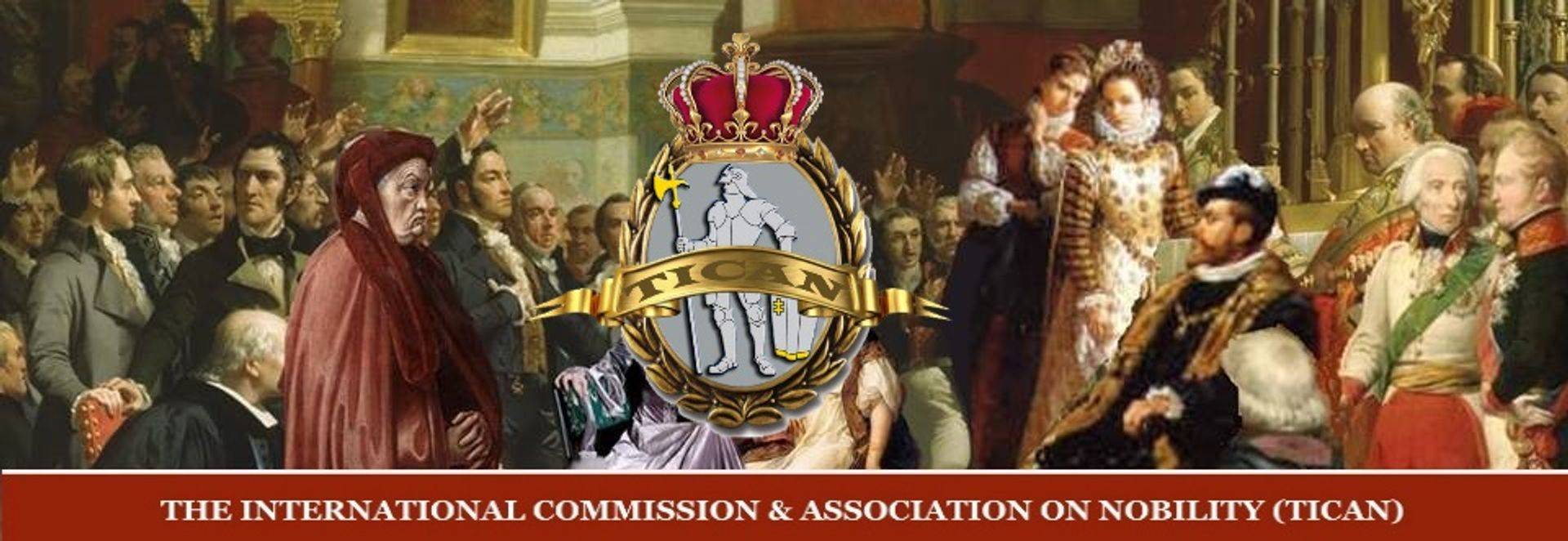
Title
ETIQUETTE OF ADDRESSING ROYALS

King Willem-Alexander and Queen Maxima of the Netherlands and their daughters (L-R) Princesses Ariana, Alexia & Amalia with some of the royal guests at their inauguration, April 30, 2013.
Left side, Front row: Sheikha Moza bint Nasser al Misned of Qatar, Prince Albert II of Monaco; Second row: Crown Prince Vajiralongkorn of Thailand, Princess Sirindhorn of Thailand; Third row: Hereditary Princess Sophie of Liechtenstein, Hereditary Prince Alois of Liechtenstein, Prince Daniel of Sweden, Crown Princess Victoria of Sweden; Fourth row: Hereditary Grand Duchess Stephanie of Luxembourg, Hereditary Grand Duke Guillaume of Luxembourg.
Right side, Front row: Princess Lalla Salma of Morocco, Crown Prince Naruhito of Japan; Second row: Charles Prince of Wales, Camilla Duchess of Cornwall, Crown Prince Frederik of Denmark, Crown Princess Mary of Denmark; Third row: Felipe Prince of Asturias, Letizia Princess of Asturias, Crown Prince Haakon of Norway, Crown Princess Mette-Marit of Norway, Prince Hassan of Jordan. Fourth row: Crown Prince Salman bin Hamad al Khalifa of Bahrain, Minister of Heritage and Culture Haitham bin Tareq al Said of Oman, Sheikh Hamed bin Zayed al Nahyan of the UAE, former US ambassador Fay Hartog-Levin.
INTRODUCTION
Attending an official or ceremonial chivalry or royal event is new experience for many persons who may be apprehensive at committing a social error or of giving offense in some way. However, royalty, nobility and Knights are rarely offended if a social error is inadvertently made.
IS THE ROYAL PROTOCOL STILL RELEVANT?
Ever since William The Conqueror obtained the crown of England, Monarchs have always been held in the highest regard and treated with the uttermost reverence and deference. That is, until now. Over the last few decades, we’ve seen such a rapid change in royal protocol and its considered importance.
Royal Protocol originates from the historical belief that Monarchs are chosen by God and therefore, should be treated with the utmost deference, as the closest thing on Earth they had to God. Royal protocol extends much further than common courtesy and even further than standard social etiquette, it is literally a law unto itself.
Royal Protocol was used to govern things like simply not touching the Monarch to more complex rules, some of which are still ‘enforced’ today.
OBLIGATION
There are no obligatory codes of behavior when meeting the King/Queen or a member of the Royal Family, but many people wish to observe the traditional forms. Some people say that they are not curtsying to the individual Royal, as such, but acknowledging what they represent – the nation.
There are two schools of thought on this and which camp you fall into probably depends of whether you think bowing is symbolic of being subject, or simply shows respect in a way that is understood within the host's culture: when in Rome one does as the Romans do. Other people say that in unofficial situations following the etiquette of another culture -- when in their domain -- is respectful. So, a bow does not indicate one is a subject: it just means one is a respectful guest.
Most royal courts employ someone to regulate etiquette. For specific addresses in different countries, you might consider contacting that office to find out more. They have often published books and leaflets with all the finer points.
Generally, you should address each class of people separately, using their distinct address. To address a prince or princess if he or she is not a member of the ruling family, for example, France, Italy and Russia had and still have princes and princesses who were not immediate family members of the king or queen. Treat them as you would treat normal royalty that are members of the ruling family.
Generally elected officials of the U.S. Government who representing his government at an event and active U.S. military members in uniform , neither bow nor curtsy to royals , but do shake hands when the royal offers a hand. elected officials and military person, when not acting in official capacity, may bow or curtsy royals.
ADDRESSING ROYALTY IN PERSON

If you can meet royalty, or if you're writing a letter to someone of royal ranking, you need to know how to correctly address them. You want to make sure you do not displease a member of a royal family. You need to learn the proper title to use given the royal person's ranking and ensure you follow rules for conduct when in their presence.
Traditional greetings such as bowing for a man or giving a curtsy for women are thought of as outdated as "we live in the 21st century". If some people wish to observe the custom, men and women can neck bow from the head only, or women can do a small curtsy.
"To properly curtsy, you place the right foot behind the left and then it's just a slight bob, what you don't want is when a lady goes too far down and then she can't come up."
- Give a head bow or a curtsy. When meeting a royal person, it's important you offer a bow or a curtsy. This is considered a formality, especially when meeting a member of the British royal family.
- If you're male, you should do a neck bow. This simply means bowing by nodding your head.
Choose the proper greeting for emperors, kings, and queens.
These are among the highest-ranking types of royalty, so be sure to address them properly. Emperors, kings, and queens should all be addressed differently.
- When addressing an emperor, you would address him or her as "His or Her Imperial Majesty, Emperor of (Name of Country)."
- When addressing a king, say, "His Majesty, the King." When addressing a queen, say, "Her Majesty, the Queen."
Call princes and princesses by the proper title.
As these are generally the second highest ranking royals, be sure to address them properly. Princes and princesses must be addressed differently.
- For a prince, say, "His Royal Highness, Prince of (Name of Country).
- For a princess, say, "Her Royal Highness, Princess of (Name of Country).
Select the right term for dukes and duchesses.
There are also formal titles required here. When meeting a duke or a duchess, a formal greeting is necessary.
- For a duke, say, "His Grace, the Duke of (Name of Country).
- For a duchess, say, "Her Grace, the Duchess of (Name of Country).
Make sure you know the proper titles for lower ranking royalty.
There are various other forms of lower ranking royalty, such as barons, knights, marquees, earls, and countesses. There are proper titles for these people as well that must be used when you address them.
Some titles are simple. For example, a knight is simply addressed as "Sir" followed by his name, and a knight's wife is addressed as "Lady," followed by her name. The same is true for baronets and their wives.
Royal people that fall between knights and baronets and positions like king and queen are usually addressed as, "The Right Honorable," followed by their name. A marquess, for examples, would be addressed as "The Right Honorable."
Behaving Appropriately
- Follow rules regarding physical touch. You do not want to offend a king or queen by touching them. You should always wait for royalty to touch you first.
- Do not attempt a handshake until a person of royal ranking has reached out to you. The protocol is to stand up and wait for the royal to extend their hand to you and say, "how do you do?"
Avoid touching a person of royal ranking during conversation.
- Opt for formal attire when meeting royalty. Dress your best if you know you are meeting royalty. Formal wear be a gesture of respect.
- Avoid things like sleeveless clothing or casual wear.
- Dress your best. Bring out your fanciest clothing, and make sure any outfit you choose is clean and free of stains, rips, or holes.
Stay somewhat formal in your interactions. You do not want to come off as too informal when meeting royalty. Avoid addressing people of royal ranking by their first name or nickname. You should also avoid laughing or making jokes. Always make eye contact when someone of royal ranking is speaking. You want to make sure you're giving royalty your full attention.
Body language
No slouching or arms crossed. When you are standing you can hold your hands clasped in front of you or you can put your hands behind your back.
Social kissing or Continental greeting
You would never kiss a royal unless you were a family member or close friend. It's up to the woman if she wants to give a cheek kiss, her lead should be followed. The Continental kissing is signaled when the shoulders are taken and held while the kisses are given.
To cheek kiss correctly, you place your right cheek against their right cheek, but you don't air kiss or make the loud pucker noise.
Sometimes the continental kiss greetings is followed by a handshake(where the two persons are males). The continental kiss is generally only used immediately before or after a presentation. However, the continental kiss greeting is appropriate for other circumstance. Americans are not familiar with the form of greeting, especially between males, and should be aware of its properly.
In Britain it's one kiss, but most follow the French and Italian rule and give two.
The Courtly kiss to the hand
If you are male and the royal female offers her hand with the palm down and the back of the hand up, you have received the signal for the hand kiss. Use your right hand to take her hand at the fingers, bow slightly while raising her hand and kiss lightly and dryly the back of her hand; then, still holding her hand, gracefully bring it back down until she withdraws the hand. This action is done quickly and smoothly, and only if the hand is offered as described. If the royal female offers a hand as for man´s handshake, do not attempt a hand kiss, but shake hands.
SITTING AT DINNER TABLE
Whether you’re grabbing a quick lunch with colleagues or need to impress a client at a formal dinner, maintaining a professional image is important.
The foundation of proper etiquette is behavior that is accepted as gracious and polite in social, professional, and family situations. Good manners can mean the difference between success and failure in many aspects of life. Knowing and exhibiting proper etiquette is essential to any civilization.
If there is a place card at your seat, the card will face you.The place card allows you to locate your proper position and allows those sitting next to you to see who you are. If a place card is too far away to easily read, you are not expected to have dinner conversation with that person.
After making acquaintance with those to your right and left, you will allow them some time to glance at your place card to fix your name in their minds. If someone is sitting across from you, and if the dinner table is not too wide to prevent casual conversation, unobtrusively turn your place card around so that the opposite persons can see it, then introduce yourself a short time after. some place cards have the name on both sides, thus eliminating the need to turn the card.
When sitting at table, hand shakes are not usually given when introductions are made. However, if a hand shake is offered, you should take it. You should introduce yourself to your immediate table mates if they are not known to you.Do not ignore to your right or left. If the table is not a great size so that conversation is convenient, you should speak to those across from you. do not leave your seat to introduce yourself to others after you have seated yourself for dinner, but, if the table seats eight or fewer, you may walk around the table to introduce yourself to those already seated before you seat yourself.
If you are in doubt about matters of dining (which for to use? which spoon?) these topics are covered in etiquette books, readily available at the local library, but an easy solution is to quietly follow the lead of the head person at your table who, even if wrong, has the advantage of being at the head of the table!
For almost all meals, if you are wondering what utensil to use, start from the outside and work your way in. So, if you are served a salad first, use the fork set to the far left of your plate.
For more information on the rest of the top 10 table manners tips, visit table manners section. The following links will take you to more detailed information to help refine your dining etiquette skills.
How to keep your legs at table
With ladies who wear skirts we always say legs together with your legs at an angle to the left or the right.
One of the worst things a woman in the royal family can do—as far as etiquette rules go—is sit with her legs crossed at the knee. Legs and knees must be kept together, although crossing at the ankle is fine. One popular pose is called “the duchess slant,” coined by Beaumont Etiquette and named for the Duchess of Cambridge, Kate Middleton. Her go-to sitting position involves keeping her knees and ankles tightly together and slanting her legs to the side. It keeps her posture modest and makes her legs appear longer. In fact, the late Princess Diana of Wales was known to sit the exact same way.
etiquette rules go—is sit with her legs crossed at the knee. Legs and knees must be kept together, although crossing at the ankle is fine. One popular pose is called “the duchess slant,” coined by Beaumont Etiquette and named for the Duchess of Cambridge, Kate Middleton. Her go-to sitting position involves keeping her knees and ankles tightly together and slanting her legs to the side. It keeps her posture modest and makes her legs appear longer. In fact, the late Princess Diana of Wales was known to sit the exact same way.
This is best seen with Catherine, Duchess of Cambridge, who sits with her legs angled to the right. Queen Elizabeth keeps her legs together in the center.
Ladies shouldn't sit cross legged, but you can cross them at the ankles.
When it was noted that Tasmanian-born Mary, Crown Princess of Denmark, often sits with her legs crossed, there are different rules of etiquette depending on the country.
Gents can cross their legs and put their hands on their lap as often seen with Prince Charles, but they should never sit cross legged (knee bent outwards).
Table manners
Table manners are not arcane, they are a courtesy. Eating is not an attractive function - manners make this essential process seem a little more attractive. This American habit of stabbing food, cutting around it, then shoveling it into your mouth is just too ghastly for words.

As your mother probably often told you, “No wrists or hands on the table”. Get your elbows off the table! It's not mannerly to place your elbows on the table, lean forward, and get all comfortable during dinner. Research into body language has also taught us that the more we lean towards people while they’re speaking, the more it’s evident to them that we’re interested in what they’re saying.
Elbows should be off the table when you are eating, specifically when you are holding a utensil, food or a cup in your hands. Elbows should be close to your sides- not winged out when you are using your utensils. A proper hold on the utensils and proper poster will help your elbows stay off the table. It is generally okay to have your elbows on the table before or after the meal, in between courses, or if your hands are empty. When in doubt, it is better to keep your elbows off the table.
First, in "stately" society, any appearance of being overly indulged in your food might be low and peasant-like. So, leaning forward, placing your elbows on the table, and, God forbid, embracing your plate with one arm while you lean over it to shovel food into your mouth, would show you to be of "low ordinary person." You are not supposed to make a big deal about your food and act like you are starving. This is still part of our culture and although we all might eat quickly and without regard for appearance from time to time, when we see someone else at the table doing it, we find it a bit off-putting.
Napkin etiquette
During formal occasions, before unfolding the napkin, wait for the hostess to remove her napkin from the table and unfold it in her lap.
- Place the napkin in your lap upon seating.
- When leaving the table temporarily, put the napkin on your chair.
- At the meal's end, fold your napkin and place it to the left of your place setting.
Read more table manners tips for using your napkin in the napkin etiquette section.
Hold utensils in the correct hands

You may not put much thought into how you cut your food, but the royal family takes dining etiquette very seriously. They hold knives in their right hand and forks in their left with the tines facing down. Instead of stabbing their food, they balance food on back of their forks, then bring it to their mouth. Sure, it’s proper, but it sounds like it turns eating into an acrobatic feat.
Eating and Talking
Never eat with your mouth open or talk with your mouth full. It is fine, however, to carry on eating during a conversation. This can be awkward if one person does not pick up their knife and fork out of mistaken courtesy, while the other person is talking. It is not rude just to nod, for example, or to wait a few moments for someone to finish a mouthful. Working out how to eat and talk is part of good table manners and an essential social skill. It is, however, impolite to continue eating during speeches or if there is a performance, such as singing.
If you need to use the restroom during a meal, they don’t announce your intention. Simply say, “Excuse me,” and leave it at that. If you are not done eating, cross the utensils so wait staff know not to take the plate.

When finished with the meal, place utensils at an angle, putting the handles at the bottom right of the plate.

ADDRESSING A LETTER TO ROYALTY
In the United Kingdom, there is a royal family so the nobles, dukes, marquesses, earls, viscounts, barons, etc. are still officially addressed by their noble titles. Same is true in Saudi Arabia, Malaysia, Japan and other countries where the head of state is a hereditary monarch.
Royalty & nobility all over the world are accustomed to being addressed with the British forms when the language is English
Unless the writer is personally known to the member of the Royal Family, it is usual to write to the private secretary, equerry or lady-in-waiting. Letters should be addressed to the holder of the office and not by name. Subsequent correspondence should be sent to the writer of the reply.
Alternatively, correspondents may send their formal letter to the member of the Royal Family via the private secretary or lady in- waiting with a covering letter, saying ‘please will you lay my letter before Her Majesty or His/Her Royal Highness…’
If communicating directly with a member of the Royal Family the letter should begin ‘Sir/Madam’ and end ‘I have the honor to remain, Sir/Madam, Your Royal Highness’s most humble and obedient servant’. In the body of the letter substitute ‘Your Royal Highness’ for ‘you’ and ‘Your Royal Highness’s’ for ‘your’.
Begin the letter with a proper salutation. If you're writing a letter to royalty, your salutation needs to be slightly more formal than a regular letter. Your salutation should have two lines.
- On the first line, begin with "Unto" and then include the appropriate title of address. For example, if you're writing to the queen of England, your first line would read, "Unto Her Majesty, the Queen of England."
- The second line should state who you are. A letter to royalty should not withhold the letter writer's name until the signature. If you have any titles, include them here. For example, "Lord John Smith of Scotland sends greetings."
Address the envelope correctly. How you address the envelope is also important. Addressing the envelope in an improper fashion can show disrespect. You must use royal titles on the envelope as well. Do not simply write the name of the queen. Write the title instead. For example, write "Her Majesty the Queen" on the envelope.
This format, based on the English form used for the monarch of the United Kingdom of Great Britain and Northern Ireland, is acceptable for all kings and queens, except the King of Saudi Arabia whose courtesy title is The Custodian of the Two Holy Mosques instead of His Majesty. Two holy mosques are the Masjid al-Haram in Mecca and the Al-Masjid al-Nabawi in Medina.
Envelope: The Custodian of The Two Holy Mosques
The King of Saudi Arabia
(Address)
Salutation: Your Majesty:
Currently, the Emperor of Japan is the only remaining monarch in the world reigning under the title of "Emperor". The Imperial House of Japan is the oldest continuing hereditary monarchy in the world. In the Kojiki (finished 712) and Nihon Shoki (finished 720), it is said that Japan was founded in 660 BC by Emperor Jimmu. The current Emperor is Akihito. He acceded the Chrysanthemum Throne upon the death of his father, Emperor Shōwa (Hirohito), in 1989.

2-8-1995 Dinner at Ambassador's Residence, Japan\ Princess Diana with the Emperor and Empress (Photo By:alpha-Globe Photos, Inc 1995)
In Japan curtsy, things are much easier, but also much stricter as well. In Japanese imperial family, there is also a thing like the Order of Precedence, which is called “imperial ranking order” (班位 in Japanese). Whenever and wherever the members of the Japanese Imperial House may be, they will always obey the order in a very strict and rigid way. Japanese people always bow to each other, but because of their different status, the degrees of bowing are different. It is also interesting to note that in Japan, the Emperor is not considered as an imperial family member, because the Members of Imperial House of Japan means the family and relatives of the current Emperor. Unlike the British Royal Family, in which the King/Queen (Regnant) is also one of the members, the member of Japanese royals who have the highest status is always the Empress, who is the spouse of the Emperor.
Emperor Akihito is referred to in Japanese as tennō heika (天皇陛下). This could be translated as “his imperial majesty,” or more literally “his majesty, the emperor.” The word heika here is the most commonly used saikō keigo in Japanese today. The courtesy title is only given to the emperor and empress, the empress dowager (the wife of the previous emperor when she survives her husband), and—theoretically—the grand empress dowager (the empress from the generation before that), although there has not been a Japanese grand empress dowager for centuries.
Other members of the imperial family are formally addressed as denka (殿下). For example, Crown Prince Naruhito in Japanese is kōtaishi denka (皇太子殿下). If heika is roughly equivalent to “majesty” in English, denka can be thought of as “highness,” the English rendering of this term preferred by the Imperial Household Agency. These courtesy titles are not universally required for most of the imperial family, however, and the standard honorific sama is also regularly seen and heard in the media. The exception is the emperor, who is always tennō heika and never sama.

Queen Elizabeth II and Prince Philip, Duke of Edinburgh greet Emperor Akihito of Japan and Empress Michiko as they arrive at a lunch for Sovereign Monarch's held in honor of Queen Elizabeth II's Diamond Jubilee, at Windsor Castle, on May 18, 2012 in Windsor, England
HOW TO ADDRESS NOBILITY FROM A COUNTRY NO LONGER HAS EITHER A KING OR QUEEN?

White dress: HRH Crown Princess Anna of Georgia
Traditional rank among European royalty, peers, and nobility is rooted in Late Antiquity and the Middle Ages. Although they vary over time and between geographic regions (for example, one region's prince might be equal to another grand duke).
Today, almost all countries have a working government that is preside over by Presidents and or Prime Ministers. There are many monarchs around the world who hold important government posts or military commands, even though they no longer rule over their subjects.
Even if some monarchy has been long abolished, there are royal families of the world that exist and are treated with respect and honor. Some royal families like the Albania, Georgia, French, Greek, Chinese, Russian and Scottish are known as “Pretenders to the Throne”. The pretender is a claimant to an abolished throne or to a throne that has been occupied by someone else. In fact, those sentences that ascertained that the various descendants in the different dynasties held the native right of pretender to the throne granted them the prerogative of granting noble titles and knighthoods in the Orders that their Sovereign House belonged to.
The Pretender to a Throne, that is a juridical person legally recognized by the International Laws, can act when the debellatio lacks, that is, the losing of the sovereignty. Every Sovereign has to carry on the royal power apart from the way in which he has been deposed. In this way, all the titles pertain to the Sovereign and to his descendants, they maintain their nature even if the Sovereign lost the real sovereignty of a Land: we have not to forget that the Sovereignty makes part of the Family Estate (even if it has lost the jus imperii - power to command -, the jus gladii - right to have the obedience of the people - and the jus majestatis - the right to have respect and honors).
Royalty and nobility often use titles rather than surnames, often change titles, and are often frequently referred to by names which are not unique, using a clear and consistent nomenclature can sometimes be difficult. See our page of “ROYAL AND NOBLE RANKS”
Several ranks were widely used (for more than a thousand years in Europe alone) for both sovereign rulers and non-sovereigns. Additional knowledge about the territory and historic period is required to know whether the rank holder was a sovereign or non-sovereign. However, joint precedence among rank holders often greatly depended on whether a rank holder was sovereign, whether of the same rank or not. This situation was most widely exemplified by the Holy Roman Empire (HRE) in Europe. Almost all the following ranks were commonly both sovereign and non-sovereign within the HRE. Outside of the HRE, the most common sovereign rank of these below was that of Prince. Within the HRE, those holding the following ranks who were also sovereigns had (enjoyed) what was known as an immediate relationship with the Emperor. Those holding non-sovereign ranks held only a mediate relationship (meaning that the civil hierarchy upwards was mediated by one or more intermediaries between the rank holder and the Emperor).
In Germany, the constitution of the Weimar Republic in 1919 ceased to accord privileges to members of dynastic and noble families. Their titles henceforth became legal parts of the family name, and traditional forms of address (e.g., "Hoheit" or "Durchlaucht") ceased to be accorded to them by governmental entities. The last title was conferred on 12 November 1918 to Kurt von Klefeld. The actual rank of a title-holder in Germany depended not only on the nominal rank of the title, but also the degree of sovereignty exercised, the rank of the title-holder's suzerain, and the length of time the family possessed its status within the nobility (Uradel, Briefadel, altfürstliche, neufürstliche, see: German nobility). Thus, any reigning sovereign ranks higher than any deposed or mediatized sovereign (e.g., the Fürst of Waldeck, sovereign until 1918, was higher than the Duke of Arenberg, head of a mediatized family, although Herzog is nominally a higher title than Fürst). However, former holders of higher titles in extant monarchies retained their relative rank, i.e., a queen dowager of Belgium outranks the reigning Prince of Liechtenstein. Members of a formerly sovereign or mediatized house rank higher than the nobility. Among the nobility, those whose titles derive from the Holy Roman Empire rank higher than the holder of an equivalent title granted by one of the German monarchs after 1806.
In Austria, nobility titles may no longer be used since 1918.
In Switzerland, nobility titles are prohibited and are not recognized as part of the family name.
In 1946, the Kingdom of Italy was replaced by a republic. Under the Italian Constitution adopted in 1948, titles of nobility are not legally recognized but not abolished. Certain predicati (territorial designations) recognized before 1922 may be attached to surnames and used in legal documents, and in most cases, these were historic feudal territories of noble families.
The Russian Nobility arose in the 14th century and essentially governed Russia until the October Revolution of 1917. In later Imperial Russia, higher ranks of state service were automatically granted nobility, not necessarily associated with landownership.
Although Georgia Republic’s politics has been taking place in the framework of a presidential republic since the nation regained its independence from the Soviet Union in 1991, the debate on monarchy, particularly its constitutional form, has never actually ceased. The issue came up most recently amid a political crisis in late 2007.
Officially ... the Republic that has no aristocracy since there is no reigning monarch and the nobility is no longer intact as it is in the UK, the Netherlands, or the UAE. So officially they are Mr. & Mrs. (or whatever honorifics they are entitled to “Dr., Lieutenant”, “Professor” etc.)
Socially ... where royals are no longer in power such titles are a matter of pride in one's heritage and personal marks of status. The titles are used at the preference of the bearer. Some do some don't, some do but only in certain circumstances. If you don't know it might be good to address them by title and if they don't like it they can say so. If you know they like to be addressed as "Count" and "Countess" using the pattern you see in the British forms as a courtesy to honor him and his heritage.
BRITISH MONARCHY

Much has been heard about how strict they are at Buckingham Palace in terms of protocol standards. The English monarchy has one of the most rigorous and extensive protocols of royal houses in Europe.
Protocol is relevant to modern royals, too. By custom, citizens of any of the realms of which Her Majesty is Head of State should bow or curtsey to any titled member of the Royal Family, including the highly-held modernizers ‘William & Kate’. Having said that, William himself has said that he doesn’t take too much to protocol, at one point to remark: “I am and always will be an HRH. But out of personal choice I like to be called William because that is my name, and I want people to call me William - for now”.
Many people regard protocol as archaic, unnecessary and misplaced in the 21st-century, others say the Monarchy wouldn’t be the same without it, whatever people’s opinion, it has declined and continues to do so and whether this is a good thing remains to be seen. On the one hand, it is modernizing the Monarchy, making it more relevant to more people and less ‘stuffy’, on the other it’s demolishing centuries of tradition.
One of the most notable pieces of court etiquette that Her Majesty herself has insisted be done away with is having to walk backwards when exiting Her presence. For obvious reasons, Her Majesty decided this had to go after seeing so many awkward exits, nowadays this is reserved merely for the most formal of occasions (the State Opening of Parliament when the Lord Chancellor hands her the speech and at Investiture Ceremonies).
The curtsy questions.
Confusingly, the official website for the British Monarchy states "there are no obligatory codes of behavior when meeting The Queen or a member of the Royal Family" before passively adding, "many people wish to observe the traditional forms."
Perhaps the thorniest of protocol issues is bowing and curtseying. This rule of thumb has caused controversy. People who meet members of the Royal Family are often told in advance the correct protocol, some conscientiously object and choose not to bow or curtsey. The Royal Household’s position on this is that people should communicate in a way that they are comfortable with. General protocol rules state that if Her Majesty is your Monarch (if you are British), then you should curtsey to her and her family; otherwise, simple politeness is the order of the day.
If you are not British, do not try to bow before the Queen. Since the monarch is only a high authority in Great Britain, it can be considered a mockery that a foreigner exaggerates his signs of respect now of knowing it. Not with this we mean that you're going to be bumping fists and say hello, but you can always tilt your head slightly as a sign of appreciation.
The Queen knows that most people get nervous about meeting her or meeting her. It is best to try to be comfortable and treat it like a normal person without forgetting the common manners. Something important: No one should be told what is discussed in intimacy with the Queen. She values the prudence of her guests very much.
The main non-negotiable for a protocol is address. It is commonly held that even if you choose not to bow or curtsey, you should at least uphold the fundamental concepts of address. For the Queen, the correct form of address is ‘Your Majesty’ at first, then ‘Ma’am’, after that. Similarly, for other members of the Royal Family, it is ‘Your Royal Highness’ at first and then ‘Sir’ or ‘Ma’am’ after that.
It’s always a question of relevance with regards to protocol, and whether it’s still sensible to keep certain aspects. When we asked etiquette and protocol expert, William Hanson how attitudes to protocol have changed over the years, he explained: “Since Her Majesty ascended to the throne in 1952, the following all these years have seen a remarkable loosening of attitudes to deference and respect.”
Tz he Royal Family are learning from the past: “The late Diana, Princess of Wales, was never allowed to live with her husband-to-be before the marriage, whereas with the now Duke and Duchess of Cambridge, this was very much encouraged.”
DON'T: Touch the royals — no matter how pretty and friendly they are.
The royal family is untouchable and we say it in the most literal sense possible. Were you thinking about hugging the queen and planting a kiss on the cheek? You better reconsider. The only way to have physical contact with a monarch is if he or she extends her hand directly in greeting and yet the grip should be light and fast.
No pats on the back, hugs or other touching — the public and media make a big deal of breaches the Queen "laughs off."
When visiting the UK, Michelle Obama was said to have committed a breach of protocol when she put her arm around The Queen during a photo, though The Queen did respond in kind. Some commentators in the UK were thrown by this, others outraged. Michelle Obama drew sniffs of disapproval in 2009 when she touched Queen Elizabeth's back in conversation, but the monarch returned the friendly gesture.
"Don't forget that the royal family are experts at this, they do this every day. Instead of bringing attention to the faux-pas, she completely diverted the attention so no one felt uncomfortable.

A traditional protocol in Europeans courts that members usually have to obey: the Countess of Wessex and the Duchess of Cambridge curtsied to the Queen, while their husbands bowed.
In Britain, there is a thing called Orders of precedence in the United Kingdom. From that page, you can see it very clearly that the British Royal Family has a strict rule for its members. This is for the very official moment, especially for how they seat and who goes first. As for the private moments, the rules, especially for female members, are strict as well. The private order of precedence is decided according to the Queen’s will, and the recent update is in favor of the “blood princess”, instead of the traditions——which places (grand) daughters-in-law higher than (grand) daughters. It is also particularly complicated from the outsiders’ point of view, that if a princess (by marriage) is accompanies by her husband, she will have a higher status and vice versa. For example, neither Princess Anne nor Princess Alexandra (the Queen’s cousin, George V’s granddaughter) should curtsy to the Duchess of Cornwall if the Prince of Wales is not present. And the rules in British Royal Family can also be flexible, the female members only should greet each other when they first meet each other on the day of event, which preventing them from curtsying all the time.

